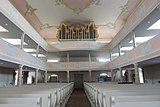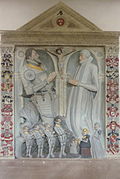Lauterbach town church
The Protestant town church Lauterbach in Lauterbach in the Hessian Vogelsbergkreis was built in the second half of the 18th century in the style of the early Rococo .
history
The predecessor of the town church was the Gothic Marienkirche, which was built in the 14th century and demolished in 1763. From 1763 to 1768 the construction of today's church took place under the master builders Georg Koch and his son Georg Veit Koch from Rodach . The town church St. Moriz in Coburg and the margrave churches of the Ansbach architect Johann David Steingruber serve as models for the interior design .
architecture
Exterior construction
The Lauterbach town church is built from sandstone blocks, the mansard roof is covered with slate . The edges of the building are reinforced by pilasters under triglyphs , over which the cranked cornice runs. The longitudinal walls are divided into seven axes , each with two portals.
The door handles of the portals are designed as fish or mermaids and come from the Lauterbach master locksmith Johann Thomas Schmidt.
The main portal is located under the tower protruding like a risalit from the south facade. It is framed by Corinthian pilasters and elaborate entablature , above which a curved window framed by volutes opens . Above the portal is the coat of arms of the Riedesel family , who ruled Lauterbach from 1429 and who introduced the Reformation there in 1527 .
The tower is divided into three floors, which are separated from each other by strong cornices . The bell storey and the octagonal structure crowned by a dome were carried out by Andreas Fink in 1821.
inner space
The church interior , designed as a hall church, corresponds to that of a preaching church . It is surrounded on three sides by two-storey galleries , which rest on Tuscan wooden pillars at the bottom and on Ionic wooden pillars at the top and terminate in the choir on both sides with glazed patronage boxes. These are directly accessible from the outside through two doors.
The ceiling and the balustrades of the galleries are decorated with stucco and rocaille cartouches in pale pink and light green tones.
Furnishing
- The chancel is dominated by a red marbled pulpit wall made of stucco marble on a black marbled base and side columns with Corinthian capitals . Its curved entablature is covered with rocailles and decorative elements in the Rococo style. In the middle there is an expansive, dark pulpit basket with a pulpit clock under a draped canopy , crowned by the Hebrew name of God JHWH in a golden halo.
- A stone Madonna sculpture from the 14th century and a relief of a Descent from the Cross from around 1500 have been preserved from the Gothic St. Mary's Church .
- The late Gothic St. Mary's altar , also from the previous church, is now kept in the Lauterbach Hohhaus Museum.
organ
There is evidence of an organ for the old town church as early as the 16th century. Philipp Ernst Wegmann from Frankfurt am Main created an organ with a 15-axis prospect in the pigtail style of the late Rococo in 1767/68 . In the center is the positive with the central round tower and two pointed towers, flanked on the outside by another round tower, with harp fields of various sizes in between. The pipe fields and the profiled cornices are crowned by veils , which also decorate the broad prospect on the sides. This served as a model for the organ of the Evangelical Church in Nieder-Moos . The pipe interior was replaced in 1906 by a new building by Friedrich Weigle, in line with contemporary tastes . In 1973, the Hillebrand brothers built a new work behind the historical front that has 35 registers distributed over three manuals and pedal. Four more registers are prepared for expansion. The organ has the following disposition :
|
|
|
|
||||||||||||||||||||||||||||||||||||||||||||||||||||||||||||||||||||||||||||||||||||||||
The registers marked with * are planned but not yet made.
- Coupling : II / I, III / I, I / P, II / P, III / P
Epitaphs
Numerous epitaphs of the Riedesel family have been preserved in the church , which were originally placed in the choir of the Gothic Marienkirche.
- Epitaph for Hermann V. Riedesel († 1532)
- Epitaph for Johann VIII. Riedesel († 1550)
- Epitaph for Hermann VI. († 1560) and Margarethe Riedesel
- Epitaph for Volprecht I († 1563) and Apollonia Riedesel, of Andreas Herber of Kassel signed
- Epitaph for Hermann VII. Riedesel († 1564)
- Epitaph for Hermann VIII. Riedesel († 1569), executed by Andreas Herber in 1580
- Epitaph for Hans Volprecht († 1569) and Anna Riedesel
- Epitaph for Georg Wolf von Rothenhan († 1590)
- Epitaph for Conrad II. († 1593), Elisabeth and Anna Riedesel, signed by Andreas Herber
- Epitaph for Volprecht II († 1610) and Beate Riedesel
- Epitaph for Johann VIII. Riedesel († 1609)
- Epitaph for Hermann Riedesel († 1632)
- Epitaph for Anna Sidonia Magdalena Riedesel († 1702)
literature
- Georg Dehio , edited by Magnus Backes: Hessen . In: Handbook of German Art Monuments . First volume. Deutscher Kunstverlag , Munich / Berlin 1966, p. 510-511 .
- Walter Krug: Cultural monuments in Hessen. City of Lauterbach (Hesse) . Konrad Theiss Verlag , Stuttgart 2007, ISBN 3-8062-2021-2 , pp. 248-254 ( monument topography Federal Republic of Germany ).
Web links
- Homepage of the parish
- State Office for the Preservation of Monuments Hesse (ed.): Marktplatz 10, Evangelical City Church In: DenkXweb, online edition of cultural monuments in Hesse
Individual evidence
- ^ Hohhaus Museum Lauterbach
- ^ Franz Bösken , Hermann Fischer : Sources and research on the organ history of the Middle Rhine. Vol. 3: Former province of Upper Hesse . Part 1 (A-L). Schott, Mainz 1988, ISBN 3-7957-1331-5 , p. 573 (Contributions to the Middle Rhine Music History 29.2).
- ^ Franz Bösken, Hermann Fischer: Sources and research on the organ history of the Middle Rhine. Vol. 3: Former province of Upper Hesse . Part 2 (M-Z). Schott, Mainz 1988, ISBN 3-7957-1331-5 , p. 678 (Contributions to the Middle Rhine Music History 29.2).
- ↑ Organ in the Evangelical City Church Lauterbach orgeldatabase (accessed June 17, 2012)
Coordinates: 50 ° 38 ′ 12.5 ″ N , 9 ° 23 ′ 46.5 ″ E













